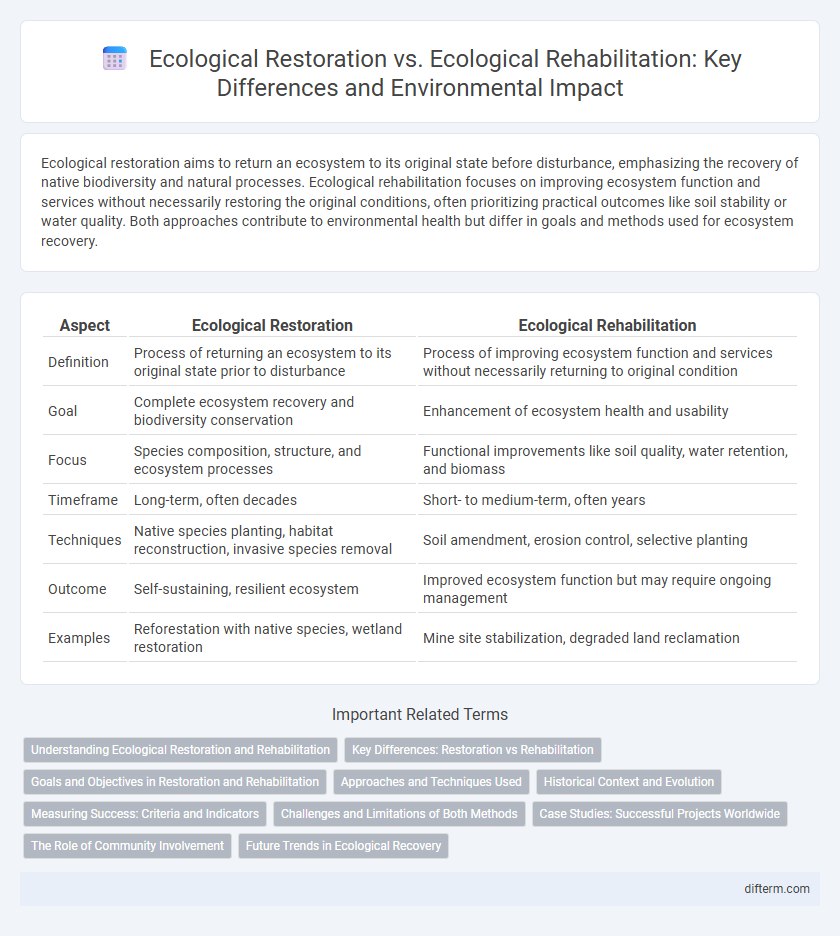Ecological restoration aims to return an ecosystem to its original state before disturbance, emphasizing the recovery of native biodiversity and natural processes. Ecological rehabilitation focuses on improving ecosystem function and services without necessarily restoring the original conditions, often prioritizing practical outcomes like soil stability or water quality. Both approaches contribute to environmental health but differ in goals and methods used for ecosystem recovery.
Table of Comparison
| Aspect | Ecological Restoration | Ecological Rehabilitation |
|---|---|---|
| Definition | Process of returning an ecosystem to its original state prior to disturbance | Process of improving ecosystem function and services without necessarily returning to original condition |
| Goal | Complete ecosystem recovery and biodiversity conservation | Enhancement of ecosystem health and usability |
| Focus | Species composition, structure, and ecosystem processes | Functional improvements like soil quality, water retention, and biomass |
| Timeframe | Long-term, often decades | Short- to medium-term, often years |
| Techniques | Native species planting, habitat reconstruction, invasive species removal | Soil amendment, erosion control, selective planting |
| Outcome | Self-sustaining, resilient ecosystem | Improved ecosystem function but may require ongoing management |
| Examples | Reforestation with native species, wetland restoration | Mine site stabilization, degraded land reclamation |
Understanding Ecological Restoration and Rehabilitation
Ecological restoration aims to return an ecosystem to its original state prior to degradation by reestablishing native species and natural processes. Ecological rehabilitation focuses on improving ecosystem functions and services without necessarily restoring the original species composition or structure. Distinguishing these approaches is crucial for tailoring conservation strategies that balance biodiversity recovery with practical land-use needs.
Key Differences: Restoration vs Rehabilitation
Ecological restoration aims to return an ecosystem to its original state before disturbance, prioritizing native species and natural processes to achieve full functional recovery. In contrast, ecological rehabilitation focuses on improving ecosystem function and services without necessarily restoring the original species composition or structure, often allowing non-native species to stabilize the area. Restoration emphasizes historical fidelity and biodiversity, while rehabilitation prioritizes practical recovery and sustainable land use.
Goals and Objectives in Restoration and Rehabilitation
Ecological restoration aims to return an ecosystem to its original, pre-disturbance condition, emphasizing biodiversity recovery, habitat functionality, and ecosystem services. Ecological rehabilitation focuses on improving ecosystem functions and services to a sustainable and productive state without necessarily restoring the original species composition or structure. Restoration targets historical reference conditions, while rehabilitation prioritizes ecosystem productivity and resilience in altered landscapes.
Approaches and Techniques Used
Ecological restoration employs techniques such as reforestation, wetland reconstruction, and soil remediation to return ecosystems to their original state, emphasizing native species reestablishment and ecosystem functionality. Ecological rehabilitation focuses on stabilizing degraded environments through methods like erosion control, invasive species management, and habitat enhancement, aiming to improve ecosystem services rather than fully restoring historical conditions. Both approaches utilize adaptive management and monitoring but differ in their goals--restoration targets full recovery, while rehabilitation seeks practical improvement within altered contexts.
Historical Context and Evolution
Ecological restoration emerged in the 20th century as a scientific approach aiming to return degraded ecosystems to their original state, emphasizing historical reference conditions and biodiversity recovery. Ecological rehabilitation developed alongside but prioritizes improving ecosystem function and services rather than full restoration to a pre-disturbance state, reflecting pragmatic adaptations to ongoing environmental challenges. Both concepts evolved with increasing understanding of ecosystem dynamics and the recognition of human influence on landscapes over time.
Measuring Success: Criteria and Indicators
Ecological restoration success is measured by criteria such as biodiversity recovery, ecosystem functionality, and resilience to disturbances, using indicators like species richness, soil health, and water quality. Ecological rehabilitation focuses on improving specific ecosystem services and conditions, with indicators including vegetation cover, erosion control, and habitat suitability. Effective measurement requires long-term monitoring and adaptive management to ensure progress toward ecological targets.
Challenges and Limitations of Both Methods
Ecological restoration faces challenges like high costs, long timelines, and difficulty in fully replicating original ecosystems, while ecological rehabilitation struggles with limited biodiversity recovery and often prioritizes functional improvement over historical accuracy. Both methods encounter limitations related to incomplete habitat restoration, invasive species management, and climate change impacts that hinder ecosystem stability. Monitoring and adaptive management are essential to address uncertainties and improve the success rates of restoration and rehabilitation projects.
Case Studies: Successful Projects Worldwide
Case studies from Australia's Great Barrier Reef illustrate ecological restoration efforts that aim to return ecosystems to their original states by reintroducing native species and rebuilding habitats. In contrast, the Chesapeake Bay Program in the United States emphasizes ecological rehabilitation by improving water quality and habitat function without fully restoring historical conditions. Both approaches highlight diverse strategies for ecosystem recovery based on regional environmental, social, and economic factors.
The Role of Community Involvement
Community involvement plays a crucial role in both ecological restoration and ecological rehabilitation by fostering local stewardship and ensuring sustainable outcomes. In ecological restoration, communities actively participate in replanting native species and monitoring biodiversity to revive original ecosystem functions. During ecological rehabilitation, local engagement supports adaptive management practices that improve ecosystem services despite altered conditions, enhancing long-term resilience.
Future Trends in Ecological Recovery
Ecological restoration aims to return degraded ecosystems to their original state, while ecological rehabilitation focuses on improving ecosystem function without full restoration. Future trends emphasize the integration of advanced remote sensing technologies and machine learning to monitor recovery progress and optimize interventions. Increased collaboration between policymakers, scientists, and local communities will drive more adaptive and resilient ecological recovery strategies.
ecological restoration vs ecological rehabilitation Infographic

 difterm.com
difterm.com